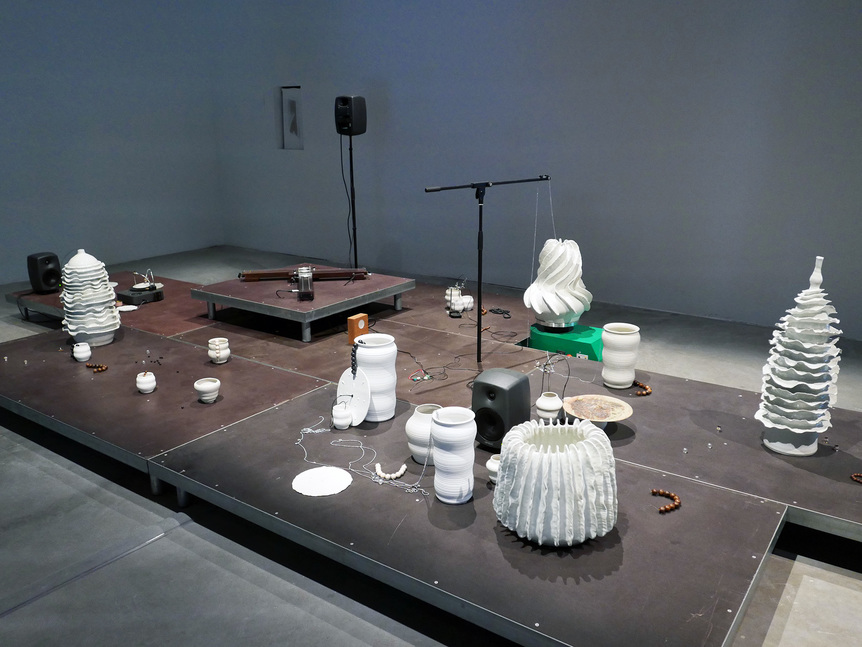
R
E
V N
E
X
T
Exterior of the Central Pavilion at the 58th Venice Biennale, with barely perceptible wisps of fog by LARA FAVARETTO as part of her multi-part project Thinking Head (2017–19). All photos by HG Masters for ArtAsiaPacific.
The title of the 58th Venice Biennale, “May You Live in Interesting Times”—aside from being an apocryphal Chinese curse, often repeated in 20th century Anglophone political discourse—brings other connotations to bear. It inevitably points to what is meant by “interesting” and will draw comparisons to Sianne Ngai’s definition in her 2008 essay “Merely Interesting,” in which the American cultural critic dissects what makes something “interesting” as “bound up with the perception of novelty (against a backdrop of the expected and familiar).” For many viewers of the Venice Biennale in 2019, that may be the curator’s intended outcome—to show works from emergent subject-identity positions that diverge from the assumed (perhaps problematically) stance of a white-Euro-American-cisgendered-heteronormative audience. But in trying to reflect the times we live in too closely through specific artists, Rugoff’s Biennale appears, on first viewing, to be perfectly expected and already quite familiar—that is, quite uninteresting in comparison to our turbulent, transitional times.
Another problem is the Biennale’s structure. There’s what curator Ralph Rugoff calls “Proposition A” in the Arsenale and “Proposition B” in the Central Pavilion of the Giardini, which just felt like the A-side and B-side of a record. The hits (wannabe and Instagrammable) are in the Arsenale, while the Giardini portion showcased other (and often lesser) sides of the practices by many of the 79 artists and groups. Why put all the blockbusters together and then all the second-tier art together? The former borders on overkill (though suiting its locale, the Venice Biennale always veers toward the dramatic) and the latter is underwhelming. And what if you start with the B-sides, as I did, in the Giardini? Seeing drawings and prints there by painters and multimedia artists (Michael Armitage, Ed Atkins, Kaari Upson, Ulrike Müller, Otobong Nkanga), photos by filmmakers (Apichatpong Weerasthakul), smaller sculptures by artists who work with dramatic scale (Yin Xiuzhen, Liu Wei, Korakrit Arunanondchai, Ryoji Ikeda), exactly fails to excite or indeed inspire interest.
Of course, not everything is so clear-cut. Sun Yuan and Peng Yu’s Can’t Help Myself (2016), a gigantic, robotic industrial arm with a rubber brush that contains a blood-red liquid oozing to the perimeters of a white platform, is a major presence in the Central Pavilion at the Giardini. It was previously shown at the Solomon R. Guggenheim Museum in New York. In the building’s upstairs gallery are a selection of paintings by Henry Taylor, Julie Mehretu, and George Condo, with sculptures by Nairy Baghramian, that work perfectly together in the expected and familiar way of a blue-chip gallery exhibition in New York or London. Only the Jimmie Durham installation Black Serpentine (2019), a slab of black-green marble, quarried in India and brought to Berlin and then Venice, is interesting in that context. Shilpa Gupta’s Untitled (2009) is a metal driveway door that mechanically opens and slams into the wall, leaving its dent in the plaster—but the artist’s For, in your tongue, I cannot fit (2017–18), a spatial symphony with 100 suspended microphones playing recordings of words by 100 imprisoned poets in the Arsenale, makes a bigger impact.
And so it goes for many artists across the two sites. Ryoji Ikeda’s data-verse 1 (2019), in the Arsenale, is an immersive and dizzying visualization of mass data accumulation, whereas his work at the Giardini is merely a narrow hallway of bright lights. Tarek Atoui’s mechanized sonic installation of unconventional, ceramic noise-making instruments The Ground (2014–19) is the outcome of more than five years of experimentation across several exhibitions and residencies, including in 2018 at the NTU CCA Singapore. But even then, many of the works are perhaps already familiar. Yin Xiuzhen’s 5.7-meter-high sculpture of a figure in the brace position of an airplane seat, Trojan (2016–17), was originally shown at Pace Beijing. Liu Wei’s massive installation of planetary-looking solid forms, Microworld (2018), comes from a Faurschou Foundation exhibition in Beijing in 2018. Korakrit Arunanondchai’s installation No history in a room filled with people with funny names 5 (2018), debuted in late 2018 at Carlos/Ishikawa gallery in London. Carol Bove sculptures are familiar from the Switzerland Pavilion in the 2017 Venice Biennale, and from several recent David Zwirner art fair booths in the intervening years. The heavy weight of the international blue-chip galleries is another topic that could be explored after some more tallying of wall labels, but that too contributed to the sense that what was meant to be interesting was again a backdrop of the expected and familiar.
HG Masters is the deputy editor and deputy publisher of ArtAsiaPacific.
The 58th Venice Biennale is on public view at various locations in Venice from May 11 to November 24, 2019.
To read more of ArtAsiaPacific’s articles, visit our Digital Library.

















